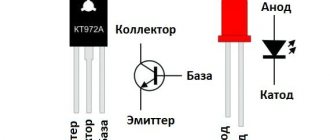How do incandescent lamps burn out?
According to GOST standards, the established voltage limits are the norm, and only for light bulbs are they critical. Let's explain. The temperature of the filament is 2-2.2 thousand °C. When a current greater than the rated current is supplied to the tungsten filament, its temperature increases by 10 percent.
The higher the temperature, the more intense the tungsten atoms evaporate. A darkened flask indicates the deposition of such atoms on it.
According to the degree of evaporation of tungsten, the thread becomes thinner; where there is a thinner section of it, that’s where it breaks off. The more often the tension rises, the sooner the thread breaks. The greatest current occurs when turned on, so constantly turning the lamp on/off affects its longevity the most.
In a switched-off lamp, the tungsten filament is cold, and its resistance is 3 times less than in the incandescent state. The following happens: at the moment of switching on, when the filament is cold, the resistance of the metal to current increases significantly (it is also called the starting current); in the heated state, the resistance of the tungsten spiral is stable.
It turns out that the less often the switching on/off occurs, the longer the lamp will work.
The manufacturer of incandescent lamps sets a standard that ensures a certain heating temperature of the filament and its light output. As a result, the service life is determined, for example, 1000 hours. The manufacturer is required to label the lamps directly on the product, and not on the packaging. Therefore, when purchasing lamps, you need to look at the rated voltage, which is indicated either on the bulb or on the base.
Buy lamps not for 230 volts, but for 240, or even better for 245, they will work much longer, unless, of course, they have mechanical defects, cracks or other damage.
The main reasons for lamp burnout
The first reason is often the poor quality of electrical appliances that use lamps. In this case, the problem can be solved by replacing the lamps with a more expensive price category. Brands such as Osram or Philips have a resource 3 times longer than domestic ones, however, it is possible that single copies from one batch burn out after using 10% of the resource.
Inexpensive lamps and chandeliers, more than half of the products are “disposable” devices with a certain unregulated working life. After working for several months, they are simply unsuitable for repair. Considering their cheapness, you can confidently exchange them for new ones.
You can easily determine the end of the device’s functionality by the smell of burning near the contact parts. If users continue to use them, correcting burnt contacts, melted cartridges, etc., then this is the reason for the burnout of even high-quality lamps.
Voltage surges and drops
Another category of problems of frequent burnout of power lines is the problem of the local electrical network of a house, apartment, or entrance. Periodic power surges occur due to poor-quality or outdated wiring, devices that have expired, insufficiently tightened contacts, and failures in step-down transformers.
Flickering lights in the apartment directly indicate such power supply faults. Because of this, not only light bulbs burn out, but also more expensive household appliances deteriorate. It is also necessary to take into account this nuance: at night, when people are sleeping, the electrical networks of residential buildings are not loaded, so the network voltage is increased.
To find out the true cause of power surges, you need to identify the source of the problem: a thorough check of the entire system will help not only eliminate the cause, but also avoid more serious situations when even a sudden fire in the home is possible.
It happens that voltage drops are small and visually invisible, which means it is more difficult to recognize the cause. But you can use a voltmeter or multimeter: measure voltage throughout the day, determine load peaks by time of day, track the stability of the current in intervals of 15-20 minutes.
In a standard household 220 V network, a deviation of +/-10% is usually allowed - this is 200-240 V. If there is an increase in this limit by 7 volts, then it is worth calling the company that services this electrical network. Specialists, having responded to complaints, will reduce the output voltage in the distribution board of the electrical substation. The cause of lamp burnout will be eliminated.
You can also eliminate the cause on your own by replacing the contacts in the socket, or using a screwdriver to bend the contact tab. It is necessary to de-energize the home electrical wiring by first turning off the circuit breaker or package switch in the panel.
Contacts
There is a common expression among electricians - “tired metal”, which refers to the wear and tear of the metal strands in the wires. The contacts, in this case, weaken and begin to burn, and the carbon deposits do not allow electricity to pass through, and the normal flow of current is disrupted.
Voltage surges are observed in a local group of devices connected to the same network line. Problem areas can be identified visually by darkened contacts (usually in junction boxes), and can be solved by replacing the wiring and switches in this section of the network.
Why LED light bulbs in a chandelier burn out - reasons and ways to eliminate them
Manufacturers position LED lighting devices as the most durable. And this is understandable if you consider how little current semiconductors consume. This advantage of LED lamps makes their purchase completely justified, despite the fact that they are somewhat more expensive than similar energy-saving products.
It becomes even more disappointing when such seemingly most reliable LED light bulbs burn out in a chandelier, sconce or other installation location. Constantly spending 190 - 220 rubles on a new lamp is not a pleasant prospect. What is the reason, what needs to be done to eliminate the possibility of something like this happening again - we’ll figure it out.
A common “diagnosis” made by various “experts” is that it’s all about the quality of the supply voltage. But is it really that simple?
Possible reasons causing LED lamps to burn out
It should be understood that no specialist can determine exactly why the LED device failed “remotely”. There is such a concept that the pros use - “repair on your fingers” or over the phone, which, in principle, is the same thing. To find the true cause, you need to take a lot of things into account.
Wiring condition
An indicator of this is the systematic burnout of LED lamps only in a specific sector (in one room, a wing of the house, and so on). It all depends on the electrical supply scheme of the building (structure). Therefore, you should not immediately blame the LED device, but start working on the track. At the same time, carry out its revision along with prevention. And then when else will you get around to it?
What to do:
- Open the terminal box and check all connections. If there are twists, especially aluminum and copper wires, redo them. There are mini-pads, sleeves, adapters on sale - the store will tell you what is more convenient to install. They cost pennies, but in the future you can rest assured that there will be no sparking, burning of wires, etc., which leads to burnout of LED lamps.
- Similarly, inspect the quality of connecting the chandelier to the intra-apartment (house) wiring.
You should not think that these are trifles that do not deserve attention. As practice shows, it is precisely such little things that lead to frequent burnout of LED lamps. It is worth repeating - they are sensitive to voltage fluctuations, they need its stability.
Condition of the chandelier
The electrical circuit of the lamp itself is simple, and even a person very far from electrical engineering can understand it.
What to do:
- Make an audit of all contacts in the cartridges. This means inspecting them + cleaning them. This mainly applies to the central, so-called “tongue”. Yes, and bending it up a little won’t hurt either. This ensures that once the LED bulb is screwed into the socket, the connection will be secure.
- Check that all wires are securely fastened in place. This is especially true for cartridges. A loose fastening screw gradually leads to burning and sparking. For a regular light bulb this is unimportant, but an LED light bulb perceives such a defect in the circuit very “painfully”. Simply put, contact burning is a change in resistance at a given point. The result is current instability, which is undesirable for the normal functioning of the LED device.
Poor quality LED lamp
If it is “made in China,” then the likely cause of the burnout is the absence of a device called a “driver” in the electrical circuit of the product. It is he who is responsible for protecting semi-automatic elements from current surges. As a rule, all cheap LED lamps are available in a budget version. They use “ballast” instead of a driver. At those moments (on/off) when current surges are maximum, it is completely useless.
External causes of lamp burnout: lamp socket
The reason for the burnout of the LN may be the electric cartridge, or rather the material from which it is made. This does not apply to ceramic cartridges, but to plastic or carbolite cartridges. Such cartridges are often limited to 60 watts.
But even at low power, plastic cartridges overheat, their body becomes deformed, cracks, and then the electrical contact in them disappears. At the same time, a crackling sound appears in the chandelier or lamp, and the lamp begins to blink unpleasantly for the eyes.
The manufacturer may have designed such cartridges for the rated voltage, but the inrush current clearly spoils them. When buying lamps, you need to keep this in mind.
If, nevertheless, you decide to make such a purchase (perhaps because of cheapness or for background lighting), then do not screw lamps more than the rated power into such lamp sockets, but rather install low-power lamps of 12-18 W.
Switch
The cause of frequent lamp burnouts may be a regular switch. As you use it, the contacts wear out and sparking appears. The new contacts are coated with silver, which wears out over time due to the exhausted commutation life.
At first the lamp will blink, and then, the next time it is turned on, it will burn out. In this case, we can only talk about replacing the switch; It is not advisable to change contacts, to unknown ones.
How can you determine that the problem is directly in the switch? This can be found out by connecting a shunt jumper, bypassing the contacts. If the lamp stops blinking, then the cause of the lamp burnout is in the switch.
When replacing it, you need to pay attention to the suitable wires: if they are blackened, it means that the contact fastening bolts were not tightened enough. When installing a new switch, you should tighten the wire fastenings more firmly.
If after replacing the switch the problem is not solved, then you need to check the strength of the connections of all wires in the apartment panel and distribution boxes, as well as in the terminal blocks of chandeliers and lamps in which the light bulbs burn out.
Aluminum+copper contact connection
One of the reasons for burnout may be connections of wires with dissimilar cores. The contact connection between aluminum and copper quickly weakens, oxidation of the twist occurs, and then the current stops passing altogether. If such dissimilar wiring still needs to be combined, then there are special connectors for this that allow you to combine aluminum wires with copper.
When installing new wiring in your home, use only copper wires.
Vibrations and temperature
Vibration may be the cause of lamp burnout. Frequent shocks or mechanical impacts that cause vibration in a room where there is incandescent lighting cause them to quickly burn out. The way out of this situation is this: incandescent lamps simply need to be replaced with another type - LED or CFL (compact fluorescent lamps).
Premature failure of an incandescent lamp also occurs due to ambient temperature. In the cold season, outdoor lamps become too cool when turned off, and when they are turned on, there is an increased load on the filament due to reduced resistance. The inrush current becomes too high, which causes premature burnout.
External factors that affect lamp life
The life of any light source depends on its quality and internal resource, but external factors have a great influence on the work process. These include:
- voltage drops in the electrical network, its instability;
- frequent switching off and on;
- disruption of contacts;
- problems in apartment electrical wiring;
- mechanical damage and vibration.
Often people do not understand why light bulbs constantly burn out and think that the reason is their poor quality. This is not always true, and if the house has old wiring, it needs to be repaired or completely replaced so that this does not lead to a short circuit or fire.
Unstable voltage
Many electrical networks experience frequent voltage surges. They cause not only burnt-out light bulbs, but also complete failure of household electrical appliances. Most often, incandescent lamps designed for a U value of 220 to 230 volts burn out due to U surges.
Helpful advice! If the voltage in your house “jumps”, buy lamps with a U value of 230 to 240 volts.
Another way is to buy fluorescent light sources that are insensitive to high voltage. You can also install a stabilizer that will timely “level” the current and prevent burnout of electrical appliances.
If you turn on the light bulbs often
When the lamp is turned off, its filament is cold and the resistance is low. When turned on, the filament heats up quickly, and the resistance becomes much higher. Turning the light on and off may cause premature wear of the tungsten filament.
The switch is damaged
When the contacts inside the switch burn out, the light bulbs quickly fail. The switch is removed, disassembled and its contacts are cleaned, carefully connecting them together. If there are serious defects, it must be thrown away and replaced with a new one. There are models of switches with dimmers. Using a dimmer you can adjust the brightness of the light. This will protect the light bulbs from U surges in the local power supply.
The problem is bad wiring contacts
Burnout of light bulbs can be caused by weak contacts of the wiring inside the chandelier or similar problems in the distribution box or panel. To avoid such situations, it is necessary to periodically inspect all contact connections, especially aluminum ones. Aluminum is a soft metal, so spontaneous loosening of such wiring is common.
Apartment wiring
Faulty electrical wiring in a house or apartment is also a common cause of light bulbs burning out. First, check the electrical panel. When the connecting screws are loosened, tighten them. When regularly “knocking out” traffic jams or an automatic system, you need to diagnose the voltage in the network and the power of the energy consumed by electrical appliances. You cannot change anything in the shields yourself; only specialists have the right to do this.
Damage may also occur in junction boxes. If burnt, black or melted wires are detected, the contacts must be restored. Before replacement, the electrical wiring is completely de-energized. When twisting, you cannot connect two wires that are made of different metals. For example, if an aluminum wire is twisted with a copper one, such a pair will always heat up - that’s why it is called galvanic. To prevent heating, connector blocks are installed.
Mechanical damage, vibration and temperature
Any lamp is a fragile and sensitive item that must be handled with care. They should not be pushed or shaken, otherwise they may fail prematurely. Strong vibration can cause loosening inside the chuck contacts and damage the tungsten filament. All lighting fixtures must be handled with care. They cannot be constantly moved from place to place.
Not only light bulbs, chandeliers and other lamps require careful handling, but also switches. Never “yank” them when using them to avoid damaging their contacts and internal parts. This can also negatively affect the operation of any lighting sources.
If electrical appliances operate under conditions of sudden temperature changes, this always provokes premature wear of the tungsten filament and, as a result, the bulb burns out.
Solution
The problem of premature lamp failure can be solved by adding a protective unit to the lighting circuit. Such a circuit can equalize small voltage drops. Only it is applicable only to incandescent or halogen lamps. This unit does not work with fluorescent and energy-saving lamps.
According to the standards of GOST 13109-97 “On voltage”, for single-phase networks of 220 volts the maximum permissible interval is 198-242 V. Taking into account the norm, the manufacturer is obliged to produce electric lamps designed for the maximum limit.
However, in reality everything is different: without violating the standard, lamps are manufactured for a nominal voltage of 230 volts. Each incandescent lamp manufacturer sets the nominal voltage for each lamp model differently. Thus, it turns out that one type of “premium class” product with an appropriate design, the other is “economy”.
There is only one way out for the population - to use products from world brands that care about their reputation in the market. This is how a light bulb business turns out.
The manufacturer produces a cheap, short-lived product, hoping that the consumer will buy it again and again. Or a well-known company produces high-quality, durable and more expensive products. What to choose is up to everyone to decide for themselves, based on their beliefs and preferences.
Methods for extending the life of incandescent lamps
It is worth remembering that when the voltage to the lamp decreases by 10%, its service life increases by one and a half times.
The retail chain sells voltage stabilizers that can be installed in an apartment, country house, or office. It is easy to choose a suitable model by consulting the seller. Using such stabilizers, not only will lamps not burn out as often, but you can also protect other household electrical equipment from damage.
There are also special electronic protection units for halogen and incandescent lamps that provide a smooth start. They are installed near ceiling chandeliers or wall lamps.
There is an excellent option for solving the problem of not only premature lamp burnout, but also for significant energy savings - instead of a switch, install a variable lighting controller (dimmer). It eliminates the occurrence of increased starting current and makes lighting comfortable for any occasion.
There is also a fairly effective way to extend the life of a lamp - a rectifying diode, which can be installed directly in the socket. This is a compact silicon diode KD-203A. The lamp will blink a little, but will burn for several years without interruption. This method will suit few people in residential premises, but for basements, utility rooms, and staircases it is the best option.
Why do light bulbs burn out so often?
Why do light bulbs in a chandelier or lamp often burn out ? There may be several reasons for this problem, and it’s good if in your case there is only one such reason. By recognizing it at an early stage, you will not only save on light bulbs, but also possibly save your electrical appliances from costly repairs. Light bulbs often burn out - there is a solution.
This article outlines the most likely causes of this problem, and here you will also find possible solutions to it.
The most common causes of lamp burnout
If your light bulbs burn out frequently , let's look at the most common one before diving into the more serious causes of this problem:
- poor quality light bulbs, solving this problem will not take any effort, you just need to replace your light bulbs with light bulbs of a higher price category, for example OSRAM or PHILIPS.
- low-quality chandelier, lamp, the Chinese market is conquering more and more space, 85% of lighting products are exclusively China, as a rule these are disposable products. Having served its term, which is not regulated by anything, the lamp can be safely thrown into the trash; it cannot be repaired. But it is precisely its operation longer than this period that leads to burnout of lamps, burnout of contacts, and melting of cartridges. It’s not difficult to identify the problem; smell the lamp closer to the socket and everything will immediately become clear.
All other causes of lamp burnout
- Voltage surges usually occur in electrical networks when any technical breakdowns occur. The reasons may be wear and tear of network elements, damaged wires, cables, burnt or poorly drawn contacts, and malfunctions of the step-down transformer. Of course, these reasons must be eliminated without fail, otherwise they can lead to serious and very unpleasant consequences such as overvoltage or fire. Be sure to draw the attention of service technicians to voltage surges.
With strong power surges, it is not difficult to identify this problem; it clearly manifests itself; when the lights are turned on, the light periodically or constantly begins to flicker, twitch, blink, all this indicates an obvious problem in the power supply.
In case of minor voltage drops, it will not be possible to visually recognize this problem; here you will have to resort to using a voltmeter or multimeter. This is an electronic device with a liquid crystal display, with which you can perform quite a lot of different functions, measure voltage, current, resistance, frequency, and so on, depending on the modification of the device. Using it, you need to measure the voltage at different times of the day and observe the stability of the voltage for 10-15 minutes. If there are periodic changes in voltage values above 7 volts, you should contact a service organization.
- increased voltage in the electrical network, this problem can only be determined by measuring the voltage with a voltmeter or multimeter. The voltage in the electrical network must be 220 volts, exceeding or underestimating by no more than 10%. Only a service organization can solve this problem by lowering the output voltage on the transformer in the distribution substation.
- the contact in the socket is weakened , here you can do it on your own, just pay attention when you next replace the light bulb to the base of the burnt out lamp and look inside the socket. If there is darkening or carbon deposits on the above-mentioned elements, then the problem is here. You can also eliminate it yourself. If the socket is screw-type (the light bulb is screwed in), turn off the power supply to the apartment and use the indicator to make sure there is no voltage. Take a flathead screwdriver and carefully bend the central contact inside the socket (petal) towards you, now the light bulb will have good contact.
- poor connection of wires , over time the metal in the connections (especially for aluminum wires) gets tired (there is such a term as “metal fatigue” wear). It shrinks, the contact pressure becomes worse and it begins to burn, soot appears, preventing the normal flow of current. In this case, voltage surges also occur, but only local ones and appear only in one specific chandelier or lamp. We solve it simply, if the situation is as described, we find and fix the problem. Such malfunctions most often can occur at the junction of the chandelier or lamp with the lighting wiring, or in the junction box.
to protect light bulbs from frequent burnout by including a protection unit for halogen and incandescent lamps in the circuit of a lamp or chandelier; it evens out small voltage drops and ensures smooth switching on of the lamp.
This unit is not suitable for: energy-saving, LED, fluorescent and LED lamps.
How much we can save by identifying the cause on our own:
- On average, 4-5 light bulbs burn out per month, the cost of each lamp ranges from 8 rubles for the cheapest incandescent lamp to 700 rubles for a good energy-saving lamp - from 40 to 3500 rubles
- Time. We also need to take into account the time spent searching for and buying a new light bulb, which in our lives is already not enough for anything - priceless
- Nerves. The situation with the continuous burning out of lamps is definitely unnerving - priceless
- Petrol. If you go to the store in your car or on public transport, you spend extra money on the trip, and if there were no reason, you would spend it on something else, more necessary - from 50 to 200 rubles











